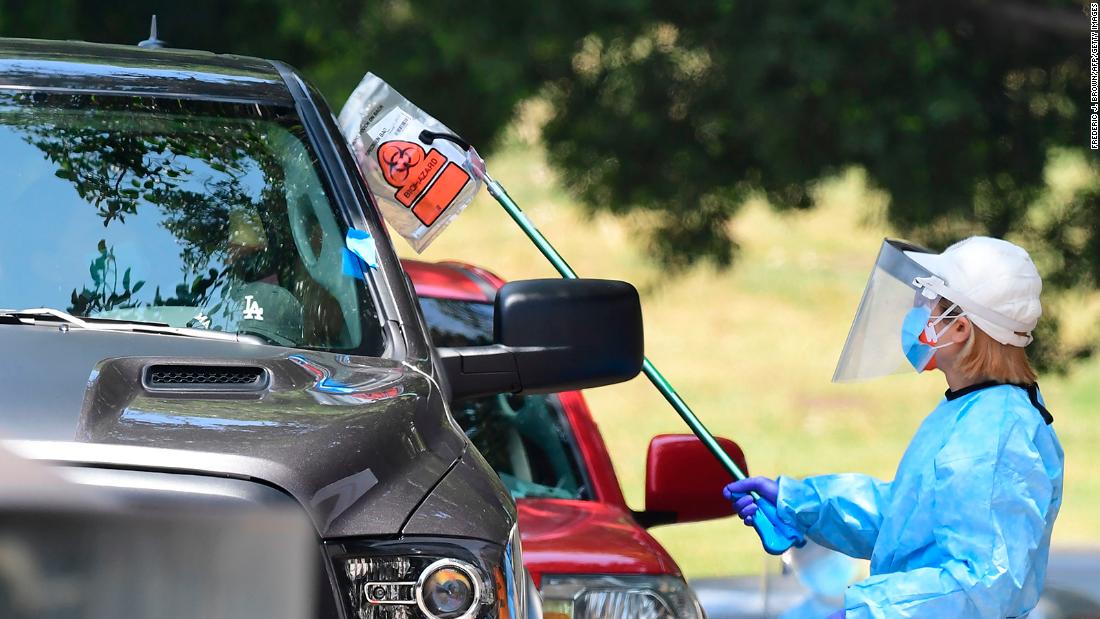
At least 37,077 coronavirus cases were reported Thursday, exceeding a previous day’s high on April 24, according to Johns Hopkins University.
The sudden increase in confirmed cases in the past few days is not a surprise, a health expert said.
“All epidemiologists were saying, screaming as loud as we could that three weeks after Memorial Day, we would have a spike in cases and five weeks after Memorial Day we would begin to see a spike in deaths, hospitalizations, and deaths.” epidemiologist Larry Brilliant told CNN’s Don Lemon on Thursday night.
“If you let everyone out without facial masks and social distancing in the midst of a pandemic, this is what was predicted.”
And while more than 2.4 million cases have been diagnosed across the country since the pandemic began, the number of people infected is likely 10 times higher. Antibody tests show that more than 20 million people have been infected with the coronavirus, most of them unknowingly, said Dr. Robert Redfield, director of the Centers for Disease Control and Prevention.
Antibody tests examine a person’s blood for signs that the immune system has responded to an infection. Federal officials have been conducting such tests across the country to determine how many people had passed undiagnosed infections.
“A good rough estimate now is 10 to 1,” said Redfield.
Between 5% and 8% of Americans have been infected with coronavirus, but the numbers vary by region. New York, once the epicenter of the pandemic, will have a higher percentage of people with past infections than some states in the west, Redfield said.
That means 90% or more have not been infected and are susceptible to the virus, underscoring the need to act aggressively to combat rising infection rates.
Some of the cases went unnoticed in part because the tests were initially limited to people who were very ill, Redfield said. As more people get tested, it’s clear that a large percentage had only mild or no symptoms.
States postpone reopening plans
The coronavirus has killed more than 124,000 people in the United States, and confirmed cases are on the rise in most of the country.
At least 30 states report an increase in new coronavirus cases this week compared to the previous week. And 13 of them report an increase of 50% or more.
“It is growing and growing rapidly across all age groups and demographics,” Arizona Governor Doug Ducey said at a press conference on Thursday. “Anyone can get this virus and anyone can transmit it.”
Arizona health officials reported new cases that topped 3,000 as of last week, a pace that could soon overwhelm hospital intensive care facilities, the governor said. “We expect our numbers to be worse next week and the week after,” Ducey said.
In Texas, Governor Greg Abbott paused at any other phase to reopen as the state recorded nearly 6,000 Covid-19 cases on Thursday. “It is quite serious,” said Dr. Peter Hotez of Baylor College of Medicine.
Florida Governor Ron DeSantis also indicated that his state would not move to relax the current restrictions. So did Governor Michelle Lujan Grisham of New Mexico, who said the state is postponing more plans for economic reopening.
California Governor Gavin Newsom declared a budget emergency to free up $ 16 billion to fight the pandemic. State hospitals have seen a 32% increase in coronavirus patients in the past two weeks, he said.
At the start of the pandemic, health experts did not focus on younger people because the priority was the older population and those with underlying health conditions.
With the numbers increasing, some states warn that the virus is affecting a broader range of people. More younger people who test positive are a “dormant fire” that will hit vulnerable populations, said Erin Bromage, a CNN medical analyst and professor of biology at the University of Massachusetts Dartmouth.
The list of the most vulnerable is updated.
Federal health authorities have updated the list of those most at risk of serious complications from the coronavirus.
The CDC added mild obesity to a list that includes the elderly, people with lung or kidney disease, and those with diabetes. People with moderate to severe asthma may also be at higher risk, as can pregnant women, the CDC said. People with cardiovascular disease, chronic kidney disease, chronic obstructive pulmonary disease are all at increased risk, said Dr. Jay Butler of the CDC.
Other conditions like sickle cell disease and poorly controlled HIV infection also increase the risk. People who have had bone marrow transplants or an organ transplant or who are taking immunosuppressive drugs are also at increased risk, the CDC said.
The CDC also removed the age-specific threshold, saying that not only those over 65 are at increased risk for serious illness.
CNN’s Jay Croft, Maggie Fox, Jen Christensen, Jennifer Henderson and Jamiel Lynch contributed to this report.
.